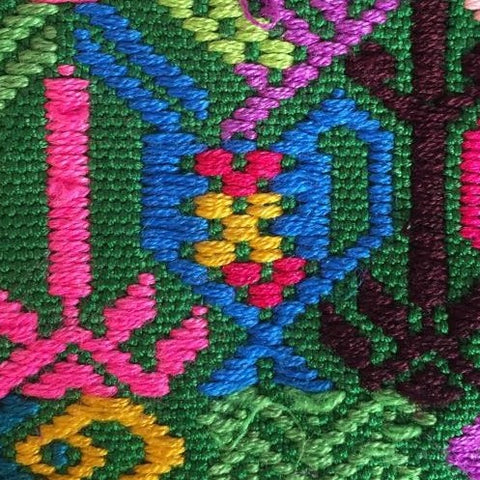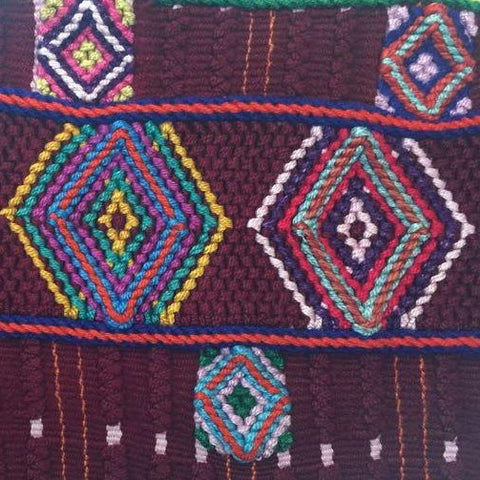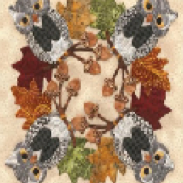Géométrique
Anthropomorphe
Zoomorphe
Nature
Objets
Répétitif
Exemples des motifs des nattes vili
| En langue Vili, veut dire, "le mur ". On dit qu'il symbolise les murs d'une maison villageoise. | 
"Bibaka"
|
| Grâce au profondeur donné par ses formes géométriques, ce motif s'appelle "le nid du pigeon". | 
"Ijoisimabemba"
|
| La complexité de ce motif nécessite qu'on le tisse exclusivement la journée. Kulemoine veut dire, littéralement, "tisse-moi la journée". | 
"Kulemoine"
|
| Les bandes diagonaux au bord de cette natte symbolise des côtes, et les quatre formes diamantées à chaque côté sont les yeux de ce "serpente de deux têtes". | 
"Tchinyenjile"
|
| Les petites formes diamantées sont répétées par les diamantes plus grandes qui les entourent. Les petits diamantes représentent des coquillages, donnant ce motif son nom. | 
"Masefi"
|
| Les triangles divergentes sur cette natte représentent un enfant têtu. En Vili, "Lilembe" veut dire "l'enfant de tête dure". | 
"Lilembe"
|
A l'époque coloniale, les européens sont venus avec de nouveaux pagnes, comprenant le "plaid" depuis Grande Bretagne. Cette natte est une réflexion des nouvelles modes apportées par les explorateurs, les marchantes, et les missionnaires. Suali veut dire "pagne" en langue vili. La natte montrée ici est rendue encore plus complexe par l'inclusion d'un deuxième motif, "Masefi".

"Suali"
|
Mayan symbolism
 “Long
ago, the people of the rainy, mountainous region of Verapaz were
trembling from the cold because they did not have clothes. From the
heavens, the goddess Itzam saw their suffering and came down to Earth.
She visited a woman in her house and tried to teach her how to weave,
but the woman simply did not understand. Just as the goddess was about
to give up, she saw a spider weaving its web. The deity told the woman
to watch how the spider worked, and thanks to this demonstration the
woman captured the essence of weaving.”
“Long
ago, the people of the rainy, mountainous region of Verapaz were
trembling from the cold because they did not have clothes. From the
heavens, the goddess Itzam saw their suffering and came down to Earth.
She visited a woman in her house and tried to teach her how to weave,
but the woman simply did not understand. Just as the goddess was about
to give up, she saw a spider weaving its web. The deity told the woman
to watch how the spider worked, and thanks to this demonstration the
woman captured the essence of weaving.” While some of the original meanings of the symbols used in Guatemalan weaving have been lost, many of them still hold significance for Mayan communities - particularly those relating to good, evil, fertility and agriculture.
Symbols and Their Meanings
 Bats are
the guardians of the Underworld. They're considered suspicious
creatures, rich in dualities. The bat is worshipped for its rule over
the darkness, and is a powerful sign to mark against enemies. The Mayans
drew a very faint line between our concepts of good and evil: they were
seen in unison, rather than separation, and the bat is also revered for
its representation of this unison.
Bats are
the guardians of the Underworld. They're considered suspicious
creatures, rich in dualities. The bat is worshipped for its rule over
the darkness, and is a powerful sign to mark against enemies. The Mayans
drew a very faint line between our concepts of good and evil: they were
seen in unison, rather than separation, and the bat is also revered for
its representation of this unison. The butterfly,
with its wings spread, represents freedom. This freedom is sometimes
compared with that of the weaver, with her ability to weave wild stories
into her textiles. The white butterfly indicates good news and
positivity, while the black represents negativity, pain and tragedy. If a
black butterfly enters a Mayan home, it is caught and burned to rid the
house of the bad luck. Green butterflies are symbols of hope and are
welcomed into homes as omens of good health if a family member is sick.
The butterfly,
with its wings spread, represents freedom. This freedom is sometimes
compared with that of the weaver, with her ability to weave wild stories
into her textiles. The white butterfly indicates good news and
positivity, while the black represents negativity, pain and tragedy. If a
black butterfly enters a Mayan home, it is caught and burned to rid the
house of the bad luck. Green butterflies are symbols of hope and are
welcomed into homes as omens of good health if a family member is sick. The cross has
ties to both Mayan and Christian religion. The four points represent
the four directions of the winds, which give life to crops and mankind.
The Mayan cross is made from the four types of corn - white, yellow,
red, and black - which represent the parts of the human body. The cross
also signifies the dawn, the darkness, the water, and the air. This
symbol demonstrates the importance of the energies that come from each
extreme of the earth.
The cross has
ties to both Mayan and Christian religion. The four points represent
the four directions of the winds, which give life to crops and mankind.
The Mayan cross is made from the four types of corn - white, yellow,
red, and black - which represent the parts of the human body. The cross
also signifies the dawn, the darkness, the water, and the air. This
symbol demonstrates the importance of the energies that come from each
extreme of the earth. Corn
is a particularly important symbol in in Guatemalan textiles. Mayan
mythology tells that for the creation of the human being, white corn was
used for the bones, yellow corn for the muscles, black corn for the
eyes and hair, and red corn for the blood. For this reason, corn is not
just considered a source of food in rural areas: it's also part of the
ancestral, ceremonial traditions.
Corn
is a particularly important symbol in in Guatemalan textiles. Mayan
mythology tells that for the creation of the human being, white corn was
used for the bones, yellow corn for the muscles, black corn for the
eyes and hair, and red corn for the blood. For this reason, corn is not
just considered a source of food in rural areas: it's also part of the
ancestral, ceremonial traditions. The cup
symbolises the importance of sharing with others. In modern Guatemala,
this symbol has becom a fusion of Mayan and Christian beliefs. It is
sometimes understood as the cup Jesus shared with the disciples during
the last supper.
The cup
symbolises the importance of sharing with others. In modern Guatemala,
this symbol has becom a fusion of Mayan and Christian beliefs. It is
sometimes understood as the cup Jesus shared with the disciples during
the last supper. The diamond
is one of the most important symbols, and can be found in most of
Trama's products. It symbolises the arms of the weaver, with her body at
the bottom, and her textiles at the top.
The diamond
is one of the most important symbols, and can be found in most of
Trama's products. It symbolises the arms of the weaver, with her body at
the bottom, and her textiles at the top. Deer are
considered a symbol of strong, stable, regal energy by the Maya. They
represent all of the animal kingdom. Deer also encompass the four levels
of being: physical, mental, emotional and spiritual. The energies of
the deer also signify the binding forces between an individual and their
family.
Deer are
considered a symbol of strong, stable, regal energy by the Maya. They
represent all of the animal kingdom. Deer also encompass the four levels
of being: physical, mental, emotional and spiritual. The energies of
the deer also signify the binding forces between an individual and their
family.  Dolls
represent the connection between women, Mother Earth, and Ixchel, who
is the goddess of medicine, midwifery, the moon, and weaving.
Dolls
represent the connection between women, Mother Earth, and Ixchel, who
is the goddess of medicine, midwifery, the moon, and weaving. Doves are the Queens of the Heavens. These feminine birds provide nourishment for the Mayan people and renew the fruits of life.
Doves are the Queens of the Heavens. These feminine birds provide nourishment for the Mayan people and renew the fruits of life. The ancient people understood the eagle’s
calls as a warning that an earthquake or storm was on its way. In
ancient Mayan mythology, one face of the double headed eagle represents
good and the other represents evil. The creature itself represents
contemplative thought. When focused upon, this symbol assists in
accessing inner wisdom and facilitates focus. Eagles have also
traditionally been a symbol of community and cooperative unity within a
diverse group. However, the meaning of the eagle changed during the
Spanish conquest since it was featured on the coat of arms of Charles V,
who was the ruler of the Spanish empire at the time. For the indigenous
population, the eagle can therefore also represent a cruel,
unforgiving, and unfamiliar being.
The ancient people understood the eagle’s
calls as a warning that an earthquake or storm was on its way. In
ancient Mayan mythology, one face of the double headed eagle represents
good and the other represents evil. The creature itself represents
contemplative thought. When focused upon, this symbol assists in
accessing inner wisdom and facilitates focus. Eagles have also
traditionally been a symbol of community and cooperative unity within a
diverse group. However, the meaning of the eagle changed during the
Spanish conquest since it was featured on the coat of arms of Charles V,
who was the ruler of the Spanish empire at the time. For the indigenous
population, the eagle can therefore also represent a cruel,
unforgiving, and unfamiliar being. The flower
motifs used in weaving are usually the native flowers of Guatemala,
like roses, lilies, violas, pansies, gladioli, and cactus flowers. All
of these flowers bloom abundantly throughout the year. The Mayans view
flowers as symbols of life and fertility.
The flower
motifs used in weaving are usually the native flowers of Guatemala,
like roses, lilies, violas, pansies, gladioli, and cactus flowers. All
of these flowers bloom abundantly throughout the year. The Mayans view
flowers as symbols of life and fertility. The inup
is the Tree of Life, which represents the life of man - birth, growth,
reproduction and death. It also indicates love, as shown in the union
between the two people who make up the two parts of the tree. The fruits
represent their offspring. Many sacred rites are performed under the
branches of these trees.
The inup
is the Tree of Life, which represents the life of man - birth, growth,
reproduction and death. It also indicates love, as shown in the union
between the two people who make up the two parts of the tree. The fruits
represent their offspring. Many sacred rites are performed under the
branches of these trees. Mayan Gods are frequently depicted with jaguar
attributes. The jaguar is said to have the ability to cross between
worlds, as represented by daytime and nighttime. The world of the living
and the earth are associated with the day, while and the spirit world
and the ancestors are associated with the night.
Mayan Gods are frequently depicted with jaguar
attributes. The jaguar is said to have the ability to cross between
worlds, as represented by daytime and nighttime. The world of the living
and the earth are associated with the day, while and the spirit world
and the ancestors are associated with the night. The lion
is often woven by young women to demonstrate a desire to be courted. As
the king of the jungle, the lion symbol is a keeper of goods, wealth,
and good luck. Sometimes the lion is read as a representation of anger,
and is therefore never used in huipils that are worn during happy
events.
The lion
is often woven by young women to demonstrate a desire to be courted. As
the king of the jungle, the lion symbol is a keeper of goods, wealth,
and good luck. Sometimes the lion is read as a representation of anger,
and is therefore never used in huipils that are worn during happy
events. In Mayan mythology, the owl
is a symbol of death and destruction. These nocturnal birds of prey are
the mysterious messengers of dark powers. For the Quiche people, the
owl’s hoot is an omen of death.
In Mayan mythology, the owl
is a symbol of death and destruction. These nocturnal birds of prey are
the mysterious messengers of dark powers. For the Quiche people, the
owl’s hoot is an omen of death. The pitcher symbolises the head of a woman, from which her wonderful ideas for patterns and color combinations in textiles are poured.
The pitcher symbolises the head of a woman, from which her wonderful ideas for patterns and color combinations in textiles are poured. The quetzal is
the national bird of Guatemala, and one of the most important textile
symbols, often present in traditional clothing. In a number of modern
Mayan dialects, the name means ‘treasured’ or ‘sacred’. Legend has it
that long ago, the Quetzal would sing beautifully, but has been silent
since the Spanish conquest. The red chest is representative of the blood
spilled while the Mayan people tried to protect themselves and their
land.
The quetzal is
the national bird of Guatemala, and one of the most important textile
symbols, often present in traditional clothing. In a number of modern
Mayan dialects, the name means ‘treasured’ or ‘sacred’. Legend has it
that long ago, the Quetzal would sing beautifully, but has been silent
since the Spanish conquest. The red chest is representative of the blood
spilled while the Mayan people tried to protect themselves and their
land. The rooster,
like the turkey, is associated with marriage. In some Mayan
communities, proposals are accompanied by the groom's family presenting
the potential bride's family with between one and three roosters,
depending on how they regard their prospective daughter-in-law. Those
who receive three roosters can feel proud that the mother-in-law is
pleased with the union.
The rooster,
like the turkey, is associated with marriage. In some Mayan
communities, proposals are accompanied by the groom's family presenting
the potential bride's family with between one and three roosters,
depending on how they regard their prospective daughter-in-law. Those
who receive three roosters can feel proud that the mother-in-law is
pleased with the union. The serpent
appears frequently in Mayan textiles as a representation of the
representing the god Gucumatz, the creator of the world. This zigzag
design can also signify mountains, which provide clean air and
protection from sickness.
The serpent
appears frequently in Mayan textiles as a representation of the
representing the god Gucumatz, the creator of the world. This zigzag
design can also signify mountains, which provide clean air and
protection from sickness.  The sun
represents the radiant energy that contributes to the motion of the
universe. It's also symbolic of the god of corn, to whom the Maya pray
to ensure a good harvest.
The sun
represents the radiant energy that contributes to the motion of the
universe. It's also symbolic of the god of corn, to whom the Maya pray
to ensure a good harvest. Turkeys often
tell the stories of weddings. The turkey represents a proposal. Once a
Mayan couple are engaged, the groom’s family will spend the next two
years fattening up a turkey until the day of the wedding. The groom then
presents the dead turkey to the parents of his soon-to-be bride. If the
groom is rich enough, he will also give the bride’s family bread and
money.
Turkeys often
tell the stories of weddings. The turkey represents a proposal. Once a
Mayan couple are engaged, the groom’s family will spend the next two
years fattening up a turkey until the day of the wedding. The groom then
presents the dead turkey to the parents of his soon-to-be bride. If the
groom is rich enough, he will also give the bride’s family bread and
money.
The colours used in Mayan weaving also have
their own significance. Red, black, white and yellow represent the four
types of corn, and by extension, the four different elements of the body
(red for blood, black for eyes and hair, white for bones and yellow for
muscles) and the four directions of the winds: red for east, black for
west, white for north and yellow for south.
These symbols and colors are often used in the
work produced by the Trama weavers, so keep an eye out for them in
our online shop and our tienda!
Forme
wealth, prestige, and spirituality;
Pour en savoir plus











No comments :
Post a Comment